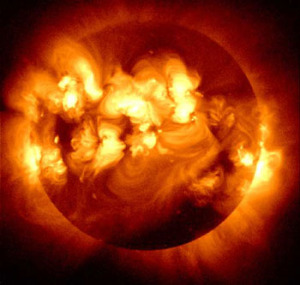Solar energy is becoming a more commercially viable alternative source of electricity since solar panels are becoming less expensive and capable of generating more power.
However, the photovoltaic cells that are currently being used to convert sunlight into electricity can only absorb and use a small fraction of that light. This inefficiency means that a significant amount of solar energy is wasted.
A new technology that has been created by researchers from Caltech, and described in a paper published online in the October 30 issue of Science Express represents the first step toward harnessing that lost energy.
Sunlight is made up of several wavelengths of light. In a traditional solar panel, silicon atoms are struck by sunlight and the atoms’ outermost electrons absorb energy from some of these wavelengths of sunlight. This causes the electrons to become active.
Once the active electrons absorb enough energy to separate from the silicon atoms, they can flow independently through the material to produce electricity. This is called the photovoltaic effect, a phenomenon that takes place in a solar panel’s photovoltaic cells.
Although silicon-based photovoltaic cells can absorb light wavelengths that fall in the visible spectrum, light that is visible to the human eye, longer wavelengths such as infrared light pass through the silicon. These wavelengths of light pass right through the silicon and never get converted to electricity. In the case of infrared, they are normally lost as unwanted heat.
Harry A. Atwater, the Howard Hughes Professor of Applied Physics and Materials Science, and director of the Resnick Sustainability Institute, was in charge of the study, explained, “The silicon absorbs only a certain fraction of the spectrum, and it’s transparent to the rest. If I put a photovoltaic module on my roof, the silicon absorbs that portion of the spectrum, and some of that light gets converted into power. But the rest of it ends up just heating up my roof.”
Atwater and his colleagues have now found a way to absorb and make use of these infrared waves with a structure composed not of silicon, but entirely of metal.
The new technique they have developed is based on a phenomenon observed in metallic structures known as plasmon resonance. Plasmons are coordinated waves, or ripples, of electrons that exist on the surfaces of metals at the point where the metal meets the air.
Since the plasmon resonances of metals are predetermined in nature, Atwater and his colleagues found that those resonances are capable of being tuned to other wavelengths when the metals are made into tiny nanostructures in the lab.
“Normally in a metal like silver or copper or gold, the density of electrons in that metal is fixed; it’s just a property of the material,” Atwater said, “but in the lab, I can add electrons to the atoms of metal nanostructures and charge them up. And when I do that, the resonance frequency will change.”
“We’ve demonstrated that these resonantly excited metal surfaces can produce a potential” — an effect very similar to rubbing a glass rod with a piece of fur: you deposit electrons on the glass rod. “You charge it up, or build up an electrostatic charge that can be discharged as a mild shock,” he says. “So similarly, exciting these metal nanostructures near their resonance charges up those metal structures, producing an electrostatic potential that you can measure.”
The solar voltaic industry is still in its infancy, with much potential left to discover and lots of sunshine going unused. This new technology is a promising discovery that may create significant waves in the solar energy industry.
UPS Battery Center is a leading manufacturer and supplier of sealed lead acid batteries for UPS systems, medical devices, alarm systems, and other industrial battery applications. We build reliable, high quality, new and refurbished products, and we recycle any qualified components as part of our green initiatives. UPS Battery Center is also a resource for relevant and current information about batteries, UPS systems, and the electrical industry
Related Articles:
Scientists Invent Spray on Solar Cells
New Innovative Substance to be used in Solar Cells and Flexible Electronics
New Materials Set Record for Efficiency of Polymer Solar Cells
Increasing the Power of Solar Cells
Recycling Old Car Batteries to Make Solar Cells




